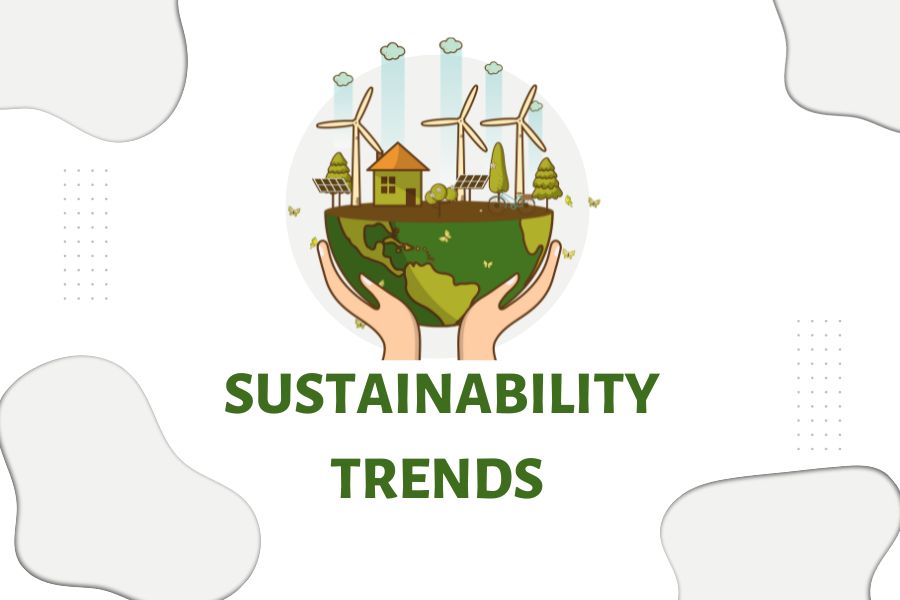Table of Contents
In a world increasingly aware of its environmental impact, sustainability trends are at the forefront of innovation and change. As we navigate 2024, it’s clear that sustainability is no longer a niche concern but a central aspect of our daily lives and business practices. This article delves into the key sustainability trends shaping our world today, offering insights into how these trends are influencing industries and consumer behaviours.
1. Renewable Energy Revolution
The transition to renewable energy sources continues to accelerate, driven by technological advancements and supportive policies. Solar, wind, and hydroelectric power are becoming more efficient and cost-effective, making them viable alternatives to fossil fuels. Innovations such as advanced energy storage solutions and smart grid technologies are further enhancing the reliability and accessibility of renewable energy.
Why It Matters:
- Reduced Carbon Footprint: Renewable energy significantly cuts greenhouse gas emissions.
- Economic Benefits: Creates jobs and stimulates economic growth.
- Energy Independence: Reduces reliance on imported fuels.
Case Study
In 2022, 36 million households around the globe installed solar panels – a 50% increase in the world’s rooftop capacity. This surge is a clear indicator of the ongoing Renewable Energy Revolution. Alongside this, people are increasingly adopting energy storage systems that electrify how they heat and cool their homes, while electric vehicle ownership is soaring. Household spending on clean energy measures – including solar panels, batteries, smart meters, and electric heating and cooling systems – reached $184 billion, marking a 340% increase from the previous year and doubling the global government climate spend. This shift demonstrates that consumers are becoming the true climate leaders. Technological advancements now allow for the integration of solar panels, batteries, and electric vehicles into a smart household system, enabling occupants to generate, use, store, save, and share energy with ease.
Source: World Economic Forum
2. Circular Economy Practices
The circular economy is redefining traditional business models by emphasising the importance of reusing, recycling, and repurposing materials. Companies are increasingly adopting practices that extend the lifecycle of products and reduce waste. From clothing brands implementing take-back programs to electronics manufacturers designing products for easy disassembly, the circular economy is driving a shift towards more sustainable consumption.
Why It Matters:
- Waste Reduction: Minimises landfill waste and pollution.
- Resource Efficiency: Conserves natural resources and reduces environmental impact.
- Economic Opportunities: Opens new markets for recycled and refurbished goods.
Case Study
SUEZ, a global leader in solid waste and water management, is dedicated to advancing sustainable resource management to enhance both environmental and economic outcomes for cities and industries. The company’s strategy revolves around two key pillars:
- Innovative Solutions for Circular Economy: SUEZ is committed to transforming its operations through cutting-edge solutions that align with circular economy principles. This includes increasing recycling efforts, expanding renewable energy production from waste, and improving alternative water resource management.
- Global Expansion and Market Diversification: To broaden its impact, SUEZ is actively pursuing new markets and customer segments worldwide. The company aims to double its plastic recycling volume by 2020, boost renewable energy production from its waste and water facilities by 10%, and enhance alternative water resource supplies.
SUEZ has formed strategic partnerships to support these goals. Collaborations with TerraCycle and Chemelot Ventures focus on developing innovative recycling technologies and establishing a new polymer recycling facility. These partnerships are designed to strengthen SUEZ’s market position and explore new opportunities in resource management.
Through these initiatives, SUEZ is positioning itself as a leader in circular economy practices, demonstrating how innovative solutions and strategic partnerships can drive sustainability and operational efficiency.
Source: CBD
3. Sustainable Fashion
The fashion industry is undergoing a transformation as consumers demand more ethical and sustainable practices. Brands are adopting eco-friendly materials, transparent supply chains, and ethical labour practices. Innovations like plant-based fabrics and zero-waste manufacturing processes are gaining traction, reflecting a broader shift toward sustainability in fashion.
Why It Matters:
- Environmental Impact: Reduces pollution and resource depletion.
- Ethical Practices: Supports fair labour conditions and animal welfare.
- Consumer Choice: Empowers consumers to make environmentally responsible choices.
Case Study
Stella McCartney, known for her dedication to cruelty-free fashion, has teamed up with Mylo Unleather and Bolt Threads to introduce a groundbreaking line of garments made from vegan mushroom leather. This collaboration marks a significant advance in sustainable fashion by replacing traditional leather with Mylo, a material derived from mushroom mycelium.
McCartney, a lifelong vegan, has long criticised the environmental damage caused by both animal and synthetic leather. Her new collection demonstrates that substantial progress in reducing fashion’s environmental footprint is possible with innovative materials. By using mushroom leather, McCartney aims to challenge industry norms and show that sustainable alternatives can be both high-quality and stylish.
This partnership not only highlights the potential of mushroom-based materials but also sets a new standard for fashion. The move away from conventional leather reduces pollution and reliance on animal farming while also educating consumers on more eco-friendly options. McCartney’s initiative is a significant step toward a more sustainable fashion industry, reflecting her ongoing commitment to reducing environmental impact.
Source: Designboom Magazine
4. Green Building and Architecture
Sustainable architecture is becoming a norm as designers and builders focus on creating energy-efficient, environmentally friendly buildings. Green building practices include using sustainable materials, implementing energy-saving technologies, and designing for optimal natural light and ventilation. These innovations reduce the environmental footprint of buildings and enhance the quality of life for occupants.
Why It Matters:
- Energy Efficiency: Lowers energy consumption and utility costs.
- Health Benefits: Improves indoor air quality and comfort.
- Long-Term Savings: Reduces maintenance and operational costs.
Case Study:
The Bosco Verticale in Milan, an eco-friendly residential building, is covered in trees and shrubs that absorb CO2, produce oxygen, and provide natural insulation. The project has become a model for sustainable urban architecture.
Source: Architectural Digest
5. Eco-Friendly Transportation
Transportation is a major contributor to greenhouse gas emissions, and sustainable solutions are emerging to address this challenge. Electric Vehicles(EVs), public transport improvements, and alternative fuels are leading the way in reducing the environmental impact of travel. As technology advances and infrastructure improves, eco-friendly transportation options are becoming more accessible to the public.
Why It Matters:
- Emission Reduction: Lowers carbon emissions and air pollution.
- Energy Efficiency: Reduces dependence on fossil fuels
- Cost Saving: Decreases fuel and maintenance expenses.
Case Study
Norway has achieved remarkable success in eco-friendly transportation by significantly boosting the adoption of zero-emission vehicles (ZEVs) and investing in a comprehensive network of charging stations. With two-thirds of new passenger vehicles sold in 2021 being fully electric and substantial progress in electrifying ferries and aviation, Norway demonstrates the benefits of shifting to sustainable transport solutions. The country’s commitment to reducing emissions and supporting innovative technologies highlights the positive impact of eco-friendly transportation on both the environment and overall mobility.
Source: OECD
6. Sustainable Food Systems
The food industry is embracing sustainability through practices such as organic farming, plant-based diets, and local sourcing. Innovations in agriculture, like vertical farming and lab-grown meat, are also making waves. These changes aim to reduce the environmental impact of food production and ensure a more resilient food system.
Why it Matters:
- Environmental Protection: Minimising land use and water consumption.
- Health Benefits: Promotes healthier eating habits and reduces pesticide exposure.
- Local Economies: Supports local farmers and reduces food miles.
Case Study:
In June 2022, Singapore made a notable advancement in sustainable food systems with the launch of Asia’s largest cultivated chicken meat facility, led by the US company Eat Just. They aimed to produce tens of thousands of pounds of lab-grown chicken. The benefits of these efforts include reducing the environmental impact of traditional meat production, creating more sustainable food supply chains, and driving innovation in food technology. These initiatives indicate a commitment to advancing more sustainable and efficient food systems for the future.
Source: CNA International
7. Smart Technologies for Sustainability
The integration of smart technology is revolutionising sustainability efforts, and Eco Renewable Energy’s products are leading the charge. Our Smart Solar Benches, WeWatt Bikes, and Energy Floors are designed to optimise resource use and enhance efficiency, paving the way for a more sustainable future.
Why It Matters
- Efficiency Gains: Our products are designed to maximise resource efficiency. For example, Smart Solar benches harness solar power to provide free WiFi while reducing demand on traditional energy sources. Similarly, WeWatt Bikes convert physical energy into electricity, making them a green alternative to traditional energy sources. This aligns well with sustainability goals and reduces reliance on non-renewable energy. Energy Floors capture kinetic energy from movement, converting it into usable power to further enhance the sustainability of events and public spaces.
- Cost Savings: By integrating these smart technologies, we can achieve significant cost savings. These solutions lower operational costs through innovative resource management. For example, the energy generated by our Smart Solar Benches can offset electricity costs, and the kinetic energy captured by Energy Floors reduces the need for additional power sources, translating into lower energy bills and maintenance costs.
Embrace the future of sustainability with our smart technologies and experience the benefits of enhanced efficiency and cost savings.
For real-world examples of how our products make a difference, visit our case studies page.
Conclusion
Sustainable Trends are shaping the future, driving innovation, and transforming industries. As we move forward, embracing trends will be crucial for achieving long-term environmental and economic sustainability. By staying informed and making conscious choices, we can all contribute to a greener, more sustainable world.
At last, Eco Renewable Energy‘s Smart Solar Benches, WeWatt Bikes, and Energy Floors are at the forefront of these trends, offering practical and innovative solutions that support a greener, more sustainable.


Recent Comments